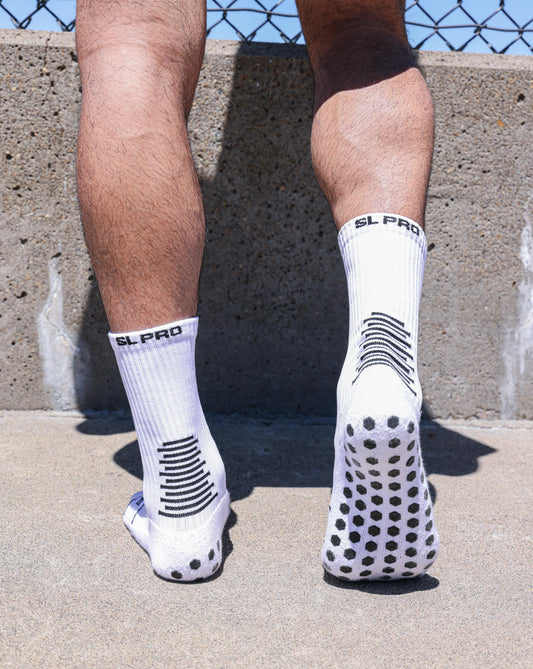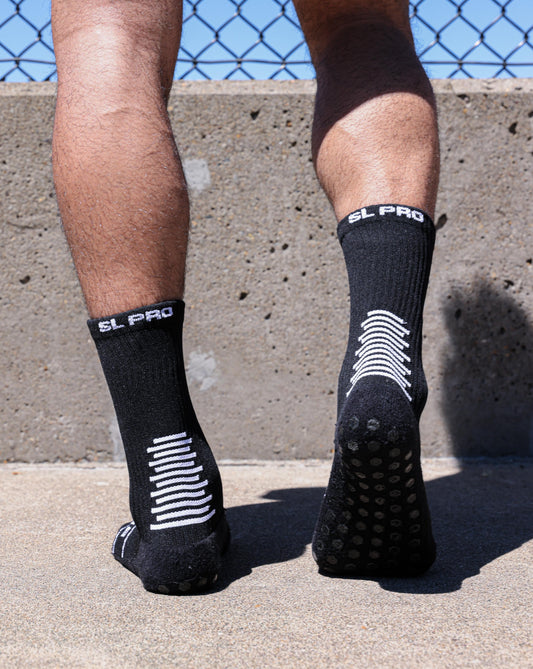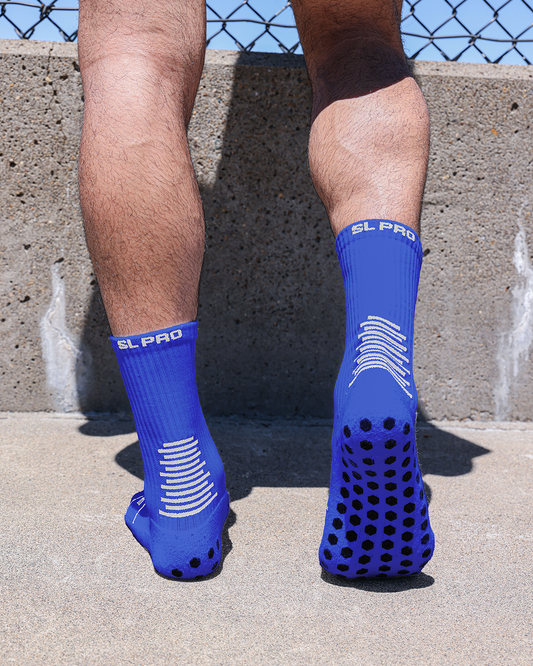Do Grip Socks Prevent Injuries? What the Science Says
In the world of soccer, every step matters. Whether you're sprinting down the flank, making a quick turn, or planting your foot for a strike, your feet are your foundation. That’s why the little things, like what socks you wear, can have a big impact.
Enter grip socks.
These high-performance socks have exploded in popularity, from grassroots teams to elite professionals. You’ll see them poking out under shin guards on Premier League fields and at weekend pickup games alike. The promise? Better traction inside your boots. But a common question keeps coming up:
Do grip socks actually prevent injuries, or is it all hype?
Let’s break it down. In this blog, we’ll explore the science, share insights from experts, and highlight real athlete experiences to help you understand whether grip socks could be a game-changer for injury prevention.
What Are Grip Socks?
Before we jump into injury prevention, let’s clarify what grip socks are.
Grip socks are athletic socks with specialized grip patterns, usually made of rubber or silicone, strategically placed on the sole and sometimes the heel and instep. These grips are designed to reduce foot slippage inside your cleats or shoes, which can improve traction, power transfer, and stability.
In essence, they help your foot move with the shoe, not within it.
Why Do Injuries Happen in Soccer?
Soccer is a high-intensity sport that requires quick changes in direction, sudden stops, and explosive movements. According several Orthopedic Surgeons, the most common soccer-related injuries include:
- Ankle sprains
- ACL tears
- Achilles tendon injuries
- Plantar fasciitis
-
Blisters and foot abrasions
One key cause of these injuries? Poor foot stability and internal slippage in the shoe. When your foot slides even slightly inside your cleat during dynamic movements, it can throw off your biomechanics and increase strain on joints, tendons, and ligaments.
This is where grip socks aim to make a difference.
The Science: Do Grip Socks Reduce Injury Risk?
Let’s get into what research and experts say.
1. Improved Proprioception and Stability
Footwear stability plays a huge role in injury prevention. Reducing internal foot slippage enhances proprioception, your body’s awareness of movement, which helps athletes respond more quickly and with better balance.
A 2018 study found that athletes wearing grip-enhanced socks showed better postural control and less foot displacement during cutting and pivoting movements. Researchers noted that improved proprioception can lower the risk of ligament sprains and overuse injuries, particularly in high-impact sports like soccer.
2. Reduced Shear Force = Fewer Blisters and Hotspots
Blisters aren’t just annoying, they can actually cause players to subconsciously adjust their gait, which can then lead to more serious injuries like Achilles strain or plantar fasciitis.
Grip socks reduce the shear force (side-to-side movement) between your foot and the inside of your shoe. A 2020 independent lab test showed that grip socks reduced in-shoe foot movement by up to 67% compared to standard athletic socks.
3. Load Transfer and Injury Mechanics
Grip socks also improve what's called load transfer efficiency. This means that when you push off the ground, more of your energy goes into the movement itself, not lost due to foot sliding inside the shoe.
As a result, muscles and tendons don’t have to work as hard to compensate for instability. Over time, this can reduce chronic overuse injuries like shin splints and IT band syndrome.
What Athletes Are Saying
Many players, both amateur and pro, swear by grip socks.
Jamal, NCAA D1 Midfielder:
“I used to roll my ankle at least twice a season. Ever since switching to grip socks, I feel more locked in. My feet aren’t sliding around anymore, especially when I’m making quick cuts. Haven’t had an ankle issue in two years.”
Elena, Semi-Pro Winger:
“Blisters were always my biggest problem. I tried tape, powders, even double socks. Grip socks were the only thing that actually worked. I haven’t had a blister since switching and my Achilles pain went away too.”
But Are Grip Socks a Silver Bullet?
Of course, no sock (no matter how grippy) can guarantee injury prevention. Injury risk in soccer is multifactorial it depends on things like:
- Footwear fit
- Field conditions
- Fatigue
- Training load
-
Biomechanics
Grip socks are a tool, not a cure-all. But they do address a very real issue that often flies under the radar: in-shoe movement and its role in injury mechanics.
Choosing the Right Grip Sock
If you’re considering making the switch, here are some tips:
✅ Check the Grip Placement
Look for socks with grip patterns that cover a wide surface area of the foot, including arches. Some brands also offer heel tabs or arch compression for added support.
✅ Fit Matters
A snug, tailored fit is crucial. Loose socks defeat the purpose. Many brands (including Sunday League) now offer multiple sizes rather than “one size fits all.”
✅ Look for Quality Materials
Moisture-wicking, breathable fabric will help with odor and keep your feet dry. Cheaper socks may lose grip after just a few washes.
Expert Tip: Layering with Cut Socks
A lot of players now cut the foot section off their team socks and wear them over grip socks (which aren't always team-issued). This gives them the performance benefit of grip socks while staying within uniform rules.
Just make sure the grip sock fits snugly and the cut sock doesn’t bunch or slide.
Final Verdict: Do Grip Socks Prevent Injuries?
They help significantly.
While grip socks aren’t a one-stop solution to all injuries, science and athlete experience suggest they do reduce key risk factors:
- They improve foot stability and proprioception.
- They reduce blister-causing friction.
-
They enhance performance mechanics by improving grip and energy transfer.
For players serious about staying healthy, especially during long seasons on turf and hard pitches, grip socks are more than a trend. They're a smart investment in your body.
TL;DR (Too Long; Didn’t Read)
Do grip socks prevent injuries?
✅ They reduce in-shoe foot slippage, improve balance, and lessen injury risk from ankle rolls, blisters, and tendon strain.
What the science says:
🔬 Studies support improved postural control and reduced foot movement inside the shoe.
What players say:
👟 Better grip = better control, fewer injuries.
Bottom line:
While not a magic bullet, grip socks are a proven tool in the injury prevention toolbox, especially for soccer players playing at high speed and intensity.
Want to Try Grip Socks?
If you’re looking to level up your gear, check out SL PRO Grip Socks, engineered with a proprietary silicone blend, four adult sizes, and trusted by players from Sunday League to the professional level.
Because every step counts. And sometimes, the right socks are all it takes to stay one step ahead.





